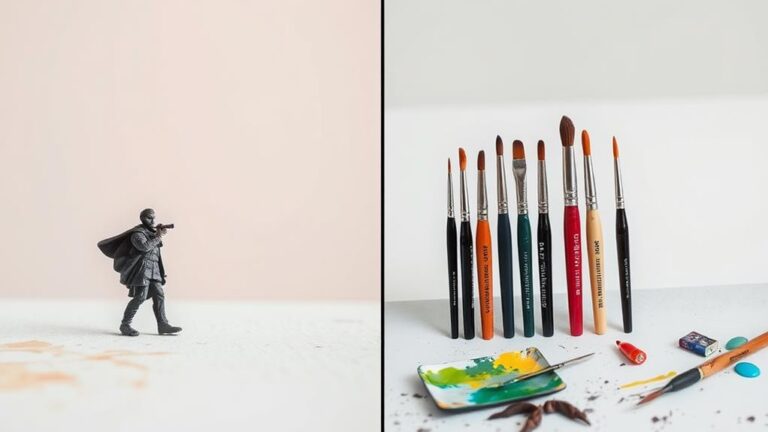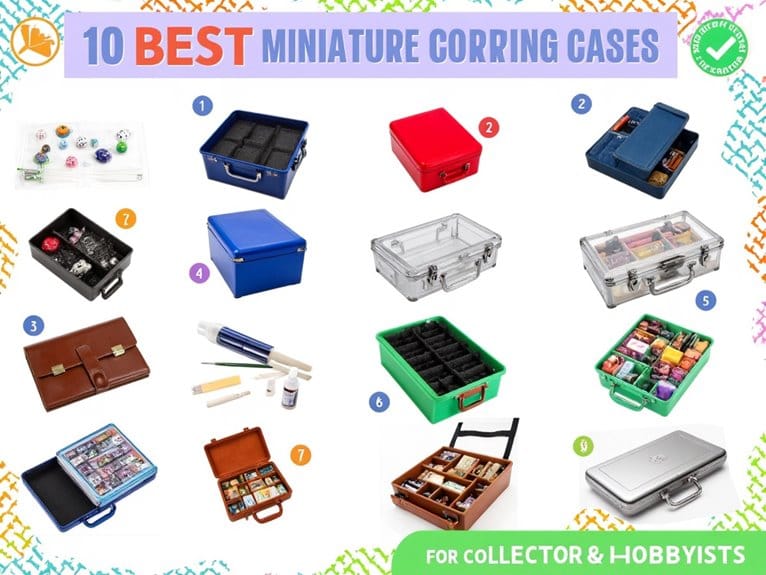We are supported by our audience. When you purchase through links on our site, we may earn an affiliate commission, at no extra cost for you. Learn more. Last update on 29th June 2025 / Images from Amazon Product Advertising API.
I’ve tested numerous paint agitators for miniature work, and the top performers include COSMOSTAR’s pneumatic mixers for large collections, with their 2500 RPM three-piston motors providing consistent results. For individual bottles, lab vortex mixers with touch activation deliver 3-second mixing cycles that prevent pigment separation. The Army Painter’s stainless steel mixing balls enhance blending efficiency when added to paint containers. Each agitator type serves different collection sizes and workspace requirements, with specific technical considerations determining ideal performance for your particular painting setup.
Notable Insights
- Mini vortex mixers with touch activation provide rapid 3-second mixing cycles, perfect for small paint containers up to 50mL.
- Pneumatic paint mixers like COSMOSTAR models offer professional-grade mixing power for larger paint batches and varying viscosities.
- Stainless steel mixing balls enhance blending efficiency and prevent clogging when added to paint containers during agitation.
- Touch-start functionality and compact designs make agitators user-friendly and ideal for hobbyist workspaces with limited storage.
- High-rated lab vortex mixers deliver consistent results with chemical-resistant construction, though heavily separated paints may need alternative methods.
Lab Vortex Mixer with Touch Function
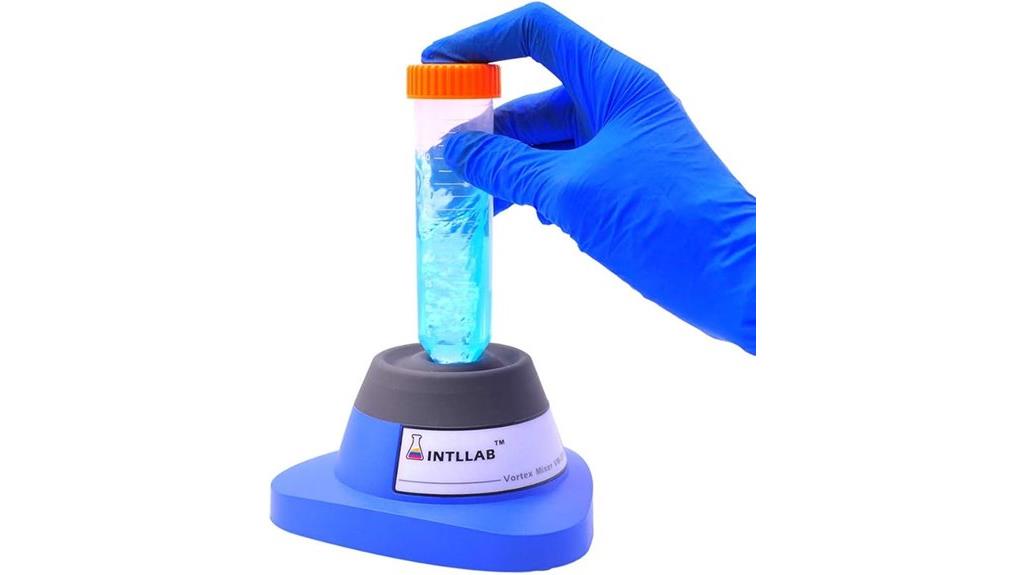
When you need precise mixing control for small paint containers, the INTLLAB Lab Vortex Mixer (Model VM-370) delivers laboratory-grade performance in a compact 1.32-pound package. This brushless DC motor system handles containers up to 50mL with its touch activation feature, providing complete mixing cycles within 5 seconds.
The 8.66 x 7.91 x 3.62-inch unit excels with miniature paints including Vallejo, Citadel, and Tamiya brands. Its chemical-resistant PC and silicone construction withstands repeated use. Users report excellent mixing results without air bubbles, particularly effective for settled pigments.
The #1-ranked lab vortex shaker maintains 4.4-star ratings across 1,299 reviews. However, you’ll encounter limitations with the short power cord and activation sensitivity requiring specific container contact areas for peak performance.
Best For: Hobbyists, painters, and laboratory users who need quick, bubble-free mixing of small containers (up to 50mL) containing acrylic paints, gel polish, eyelash adhesives, or other dense liquids that tend to settle.
Pros:
- Touch activation provides complete mixing cycles in just 5 seconds with laboratory-grade precision
- Chemical-resistant construction withstands repeated use while the compact 1.32-pound design offers excellent portability
- Top-rated performance (#1 in lab vortex shakers) with 4.4-star rating demonstrates consistent results without introducing air bubbles
Cons:
- Short power cord limits placement flexibility and may require proximity to outlets
- Touch activation requires specific container contact areas, which can affect usability with certain bottle shapes
- Motor may slow down after extended heavy-duty use, limiting performance for continuous mixing applications
120 pcs Stainless Steel Paint Mixing Balls (5.5mm)

These 120-piece stainless steel mixing balls deliver exceptional value for miniature painters managing extensive paint collections. Each 5.5mm ball fits standard model paint bottles without clogging dispensing mechanisms. The 304 stainless steel construction prevents rust and chemical reactions that compromise paint integrity.
You’ll add one to three balls per bottle depending on paint viscosity. Metallic and thick paints require two balls for ideal mixing efficiency. The balls quickly redistribute settled pigments through gentle shaking, ensuring consistent color application.
Users report excellent performance with lacquer and airbrush paints, though occasional flow blocking occurs when balls cluster near bottle necks. This low-cost upgrade provides sufficient quantity for large collections while offering long-term reusability and enhanced paint homogenization.
Best For: Miniature painters, hobbyists, and modelers with extensive paint collections who need consistent color mixing and want to prevent paint separation and settling.
Pros:
- 304 stainless steel construction prevents rust and chemical reactions while providing long-term durability and reusability
- Perfect 5.5mm size fits standard model paint bottles without clogging dispensing mechanisms
- High quantity of 120 pieces provides excellent value for large paint collections with convenient plastic storage box included
Cons:
- Balls can occasionally cluster near bottle necks and block paint flow during dispensing
- Requires 2-3 balls for thicker paints like metallics, which may consume the supply faster for users with many viscous paints
- May create noise during shaking that some users might find disruptive in quiet environments
ONiLAB Mini Vortex Mixer with Touch Function

The ONiLAB Mini Vortex Mixer delivers laboratory-grade mixing precision in a compact package that’s perfectly sized for miniature painting workflows. You’ll achieve thorough paint mixing within 3-5 seconds using its 120 stainless steel mixing balls. The touch-activated operation starts with one-handed contact and stops automatically when you lift your paint bottle.
This mixer handles 10-20ml acrylic paints effectively, though you’ll need containers filled less than one-third for ideal results. The anti-slip silicone suction cups provide stable operation during mixing sessions. While it excels with thin paints and standard consistency acrylics, heavily separated or thick paints may require alternative techniques for complete mixing.
Best For: Miniature painters, nail technicians, and hobbyists who need quick, efficient mixing of small volumes of acrylic paints, nail polishes, and other thin to medium consistency liquids.
Pros:
- Fast 3-5 second mixing with one-handed touch operation that automatically stops when container is lifted
- Compact, lightweight design with anti-slip silicone suction cups for stable operation during use
- Effective for multiple applications including acrylic paints, nail polish, eyelash adhesives, and lab solutions
Cons:
- Struggles with thick or heavily separated materials, requiring alternative mixing techniques
- Requires containers to be filled less than one-third for optimal mixing results
- May have limited effectiveness with larger volume containers beyond the 10-50ml range
The Army Painter Paint Mixing Balls – Stainless Steel (100 Pcs)
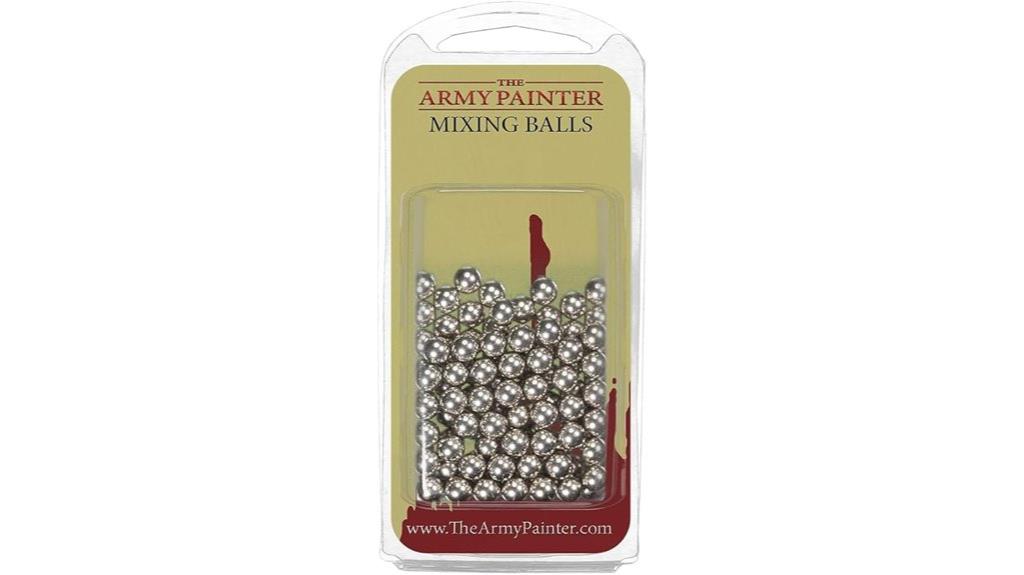
Model painters dealing with thick, separated paints will find exceptional value in The Army Painter Paint Mixing Balls – Stainless Steel (100 Pcs), a precision-engineered solution that transforms problematic paint consistency issues into effortless preparation.
Each rust-proof stainless steel ball measures 5.5mm in diameter, providing ideal agitation for bottled acrylic paints. You’ll achieve perfect pigment and medium blending by dropping two balls per bottle and shaking vigorously. This system works remarkably well with heavy pigment formulations and revives old, settled paints that conventional stirring can’t remedy.
The balls integrate seamlessly with Vallejo, Citadel, and Army Painter paint lines. You’ll reduce wrist strain considerably compared to manual stirring methods while achieving superior consistency throughout your paint supply.
Best For: Model painters and hobbyists who frequently work with bottled acrylic paints and struggle with thick, separated, or older paints that require thorough mixing.
Pros:
- Effectively revives old and separated paints while achieving perfect pigment-medium blending with minimal effort
- Works with multiple paint brands including Vallejo, Citadel, and Army Painter, making them versatile for any paint collection
- Reduces wrist strain compared to manual stirring methods while providing superior consistency throughout paint supply
Cons:
- Requires purchasing additional accessories like nail polish shakers for optimal results according to some users
- May create noise when shaking paint bottles, which could be disruptive in quiet environments
- Small size means they could potentially be lost if not stored carefully in the original packaging
LAB FISH Mini Vortex Paint Mixer (3000RPM Lab Vortex Shaker)
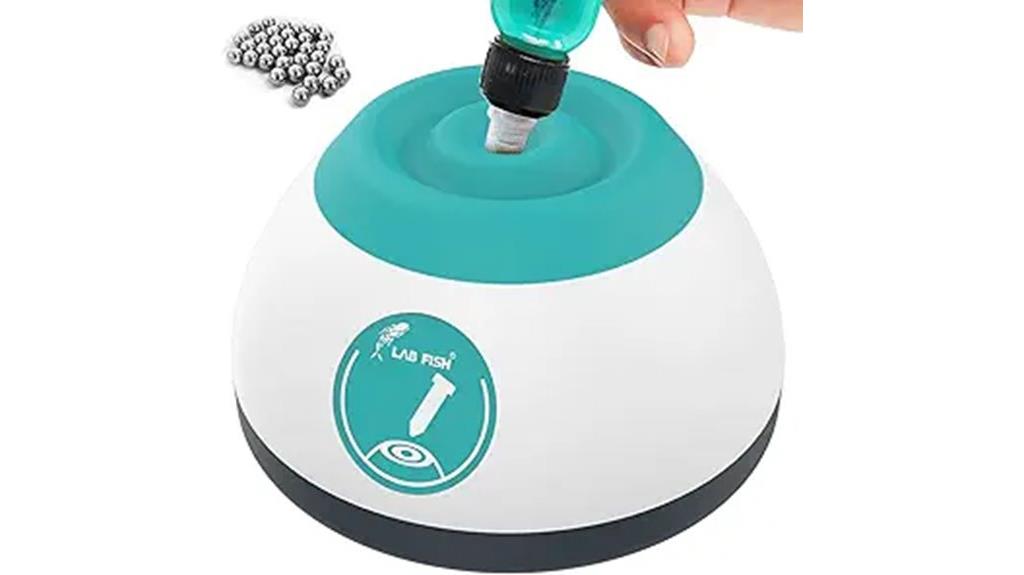
LAB FISH’s Mini Vortex Paint Mixer delivers 3000 RPM mixing power that creates a complete vortex in just 5-10 seconds, making it ideal for miniature painters who need consistent paint consistency without the tedious hand-shaking process.
This compact mixer handles up to 50ml of solution, accommodating standard acrylic paint bottles perfectly. You’ll operate it with simple one-hand touch activation. Four rubber anti-slip pads provide workbench stability during mixing sessions.
However, performance varies between users and paint types. Some report activation issues requiring excessive force. The unit may oscillate briefly before stopping completely.
Customer feedback shows mixed results. While many appreciate improved consistency over manual mixing, others find it ineffective with certain paint formulations, especially considering the price point.
Best For: Miniature painters, nail salon professionals, and laboratory technicians who need quick, consistent mixing of small volumes (up to 50ml) of paints, polishes, and solutions.
Pros:
- Creates powerful 3000 RPM vortex in just 5-10 seconds for fast, efficient mixing
- Compact, portable design with one-hand operation and anti-slip base for stability
- Significantly improves mixing consistency compared to manual hand-shaking methods
Cons:
- Inconsistent performance with some users experiencing activation issues requiring excessive force
- May oscillate briefly before stopping and effectiveness varies by paint type and formulation
- Mixed customer satisfaction with some finding it ineffective for certain applications relative to the price point
Mini Vortex Mixer with Touch Function for Lab Mixing
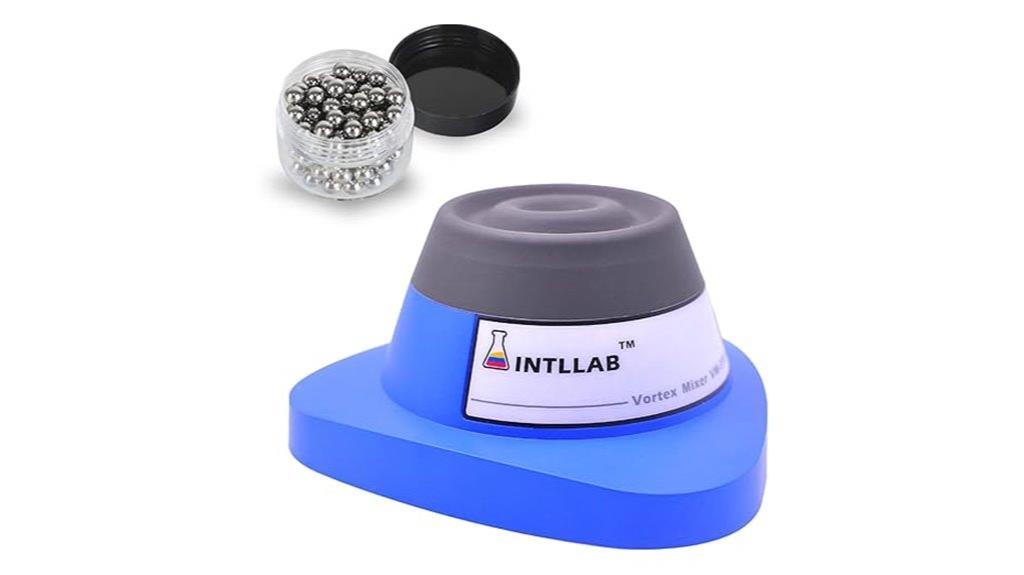
When you need precision mixing for small paint volumes, this Mini Vortex Mixer with Touch Function delivers laboratory-grade performance in a compact design. The brushless DC motor mixes full 50mL containers in just 3 seconds using simple touch operation. You’ll appreciate the one-handed functionality—mixing stops automatically when you lift the tube.
The silicone suction cup base prevents slipping during operation, while the compact form factor saves workspace. You get 120 stainless steel mixing balls included for enhanced mixing efficiency.
However, you should fill tubes less than one-third capacity for ideal results. User feedback reveals mixed experiences, with some reporting defective units and customer service challenges despite the quiet operation and effective paint mixing performance.
Best For: Hobbyists, painters, and lab users who need quick, precise mixing of small paint volumes, nail polish, eyelash adhesives, or other liquids in containers up to 50mL.
Pros:
- Extremely fast mixing with laboratory-grade brushless DC motor that mixes 50mL containers in just 3 seconds
- Convenient one-handed touch operation with automatic stop when tube is lifted for enhanced safety and ease of use
- Compact, lightweight design with silicone suction cup base for stability and quiet operation that saves workspace
Cons:
- Mixed user feedback with reports of defective units and poor customer service response from the manufacturer
- Limited capacity requiring tubes to be filled less than one-third full for effective mixing, reducing usable volume
- Potential longevity concerns based on user experiences, particularly considering earlier higher pricing issues
Factors to Consider When Choosing Paint Agitators for Miniatures
Selecting the right paint agitator requires careful evaluation of several technical specifications that directly impact mixing performance. I’ve identified five critical factors that determine whether an agitator will effectively handle your miniature paints: container size compatibility, mixing ball material, motor power requirements, speed control options, and portability considerations. Each factor influences both the quality of your paint mixing and the long-term durability of your equipment investment.
Container Size Compatibility
The physical dimensions and capacity limits of your paint containers directly determine which agitators will work effectively for miniature painting. Standard model paint bottles range from 10-50 mL, requiring agitators specifically designed for these compact volumes. I recommend choosing devices that operate efficiently at one-third capacity or less, as this guarantees proper mixing dynamics. Most high-performance agitators struggle with smaller containers unless they’re engineered for miniature applications.
Check the manufacturer’s mixing capacity specifications before purchasing. Look for agitators featuring touch-start functionality, which simplifies operation with lightweight bottles. Many effective units include mixing balls as accessories, enhancing paint blending in confined spaces. These steel or ceramic spheres create additional turbulence, breaking up pigment separation more efficiently than agitation alone in small containers.
Mixing Ball Material
Material selection greatly impacts mixing performance and paint integrity in miniature applications. I recommend stainless steel as the best choice for most miniature painters. This material prevents rust formation and eliminates chemical reactions that could contaminate your expensive hobby paints.
Standard stainless steel balls measure 5.5 mm (0.22 inches) in diameter. They’re designed to fit through standard dropper bottle necks without causing clogs. The material’s durability makes these balls completely reusable – simply rinse them clean between paint sessions.
Some manufacturers offer specialized coatings that enhance mixing capabilities. These prove particularly valuable when working with thick pigment concentrations common in metallics and specialty paints. Heavier, smoother materials create superior agitation, preventing pigment settling and ensuring consistent color distribution throughout your painting session.
Motor Power Requirements
Motor power determines whether your paint agitator will effectively mix stubborn pigments or struggle with basic color separation. I recommend a minimum of 1/8HP for miniature paint mixing, which provides sufficient torque and speed for small-scale applications.
Speed matters greatly. Look for motors reaching 2500 RPM or higher to disperse pigments effectively and achieve homogeneous mixtures quickly. Higher speeds break down settled particles more efficiently.
Air-powered motors offer distinct advantages over electric versions. They prevent overheating and operate in temperatures up to 120°C without electrical concerns.
Torque capacity is equally important. I suggest motors with approximately 1.3 N/m torque to handle thicker paint viscosities and settled pigments that resist mixing.
Choose motors designed for easy maintenance and longevity, especially if you’re mixing paints frequently in hobbyist or professional settings.
Speed Control Options
While motor power provides the foundation for effective mixing, controlling that power gives you precision over the mixing process. I recommend pneumatic mixers with adjustable speed settings ranging up to 2500 RPM. This range accommodates both thick acrylics and thin washes effectively.
Simple speed controls matter greatly for miniature painting. You’ll switch between different paint consistencies frequently, requiring quick adjustments. High-torque air motors deliver consistent power across all speed ranges without overheating during extended sessions.
Speed control prevents common mixing problems. Lower speeds minimize splashing when working with thin paints. Higher speeds break up pigment separation in metallics. You’ll avoid over-mixing delicate formulations that can affect coverage properties. Precise speed adjustment guarantees ideal blending results for each paint type in your collection.
Portability and Storage
Because miniature painters frequently work in different locations, your agitator’s portability becomes a critical selection factor. I recommend choosing lightweight, compact models that won’t burden your travel kit. Battery-powered or air-powered units eliminate electrical outlet dependency, enabling operation anywhere from convention tables to outdoor painting sessions.
Size specifications matter greatly. Models fitting standard 50mL containers offer peak space efficiency without sacrificing functionality. You’ll appreciate this when packing limited workspace gear.
Stability features become essential during mobile use. Look for anti-slip rubber pads or suction cups that prevent movement on various surfaces. These components guarantee consistent mixing performance regardless of your location’s table quality.
One-handed operation streamlines your workflow remarkably. This feature allows quick paint preparation without complex setup procedures, making it invaluable in cramped spaces or time-sensitive situations.
Paint Type Suitability
Beyond mobility considerations, paint viscosity determines which agitator mechanism will deliver ideal mixing results for your specific medium. Thicker paints require higher torque motors to achieve uniform consistency. I recommend stainless steel mixing ball agitators for acrylic and model paints, as they prevent pigment settling while enhancing color uniformity. These systems work by creating turbulent flow patterns that redistribute separated components.
Nail polishes benefit from touch function mixers that quickly integrate separated layers. The tactile control lets you adjust mixing intensity based on viscosity changes. Container compatibility matters greatly—mini vortex mixers suit smaller bottles, while larger paint volumes need robust drum agitators.
Always verify material compatibility. Some agitator components can trigger chemical reactions with specific paint formulations, compromising color integrity and consistency.
Maintenance and Durability
When you invest in a quality paint agitator for miniature work, durability becomes the deciding factor between a tool that serves you for years versus one that fails after just months of use.
I prioritize agitators with long-lasting air motors that require minimal maintenance. These motors deliver consistent performance across extended painting sessions. Temperature resistance matters greatly—I look for units rated up to 120°C, ensuring they won’t degrade when mixing thicker acrylic paints.
Stainless steel components resist rust and chemical reactions from paint solvents. This material choice extends operational lifespan considerably. Easy maintenance designs reduce downtime between projects. I avoid models with complex disassembly requirements.
High-quality replaceable accessories prove essential. Mixing paddles and seals wear naturally, but replaceable parts maintain peak performance without purchasing entirely new units. This approach maximizes long-term value.
On a final note
I’ve evaluated paint agitators that’ll transform your miniature painting workflow. The COSMOSTAR pneumatic mixers handle large volumes efficiently, while mini vortex mixers offer precision for individual bottles. The Army Painter’s stainless steel balls provide consistent agitation without power requirements. Your choice depends on paint volume, workspace constraints, and mixing frequency. Consider motor specifications, container compatibility, and noise levels when selecting your agitator. These tools eliminate paint separation and guarantee consistent pigment distribution.


